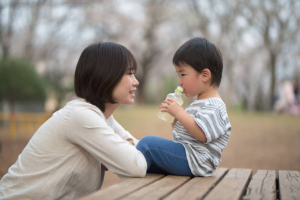
[Gentle Parent]
Many of us parents are familiar with the classic authoritarian parenting style – the tiger mom. Either we see it online, or we experienced it ourselves growing up.
It is centred around punishment and reward to discipline our children. But many of us nowadays don’t want our children to experience that.
There is a new parenting style on the rise on TikTok. It is called gentle parenting and it falls under authoritarian parenting. Let us explore what it is and how we can use it!
What is Gentle Parenting?

[VideoHive]
Gentle parenting is a parenting style that focuses on fostering the qualities that we want our children to possess by being compassionate and enforcing clear boundaries. It does not include using punishment or force to discipline our children.
Instead, it uses age-appropriate methods, empathy, and creating a partnership with our children. It prioritises communication between parent and child and emphasises mutual respect and consideration for our child’s feelings.
How does Gentle Parenting Work?

[Freepik]
In gentle parenting, we have to show consideration and acceptance of our children’s feelings by letting them experience their feelings without punishing them for crying or screaming.
Once they calm down, we give them space to express their frustrations without getting upset. This gives them a safe space to explore their feelings, helping us understand from their perspective too.
Then we explain that their feelings are validated while still letting them know what they did wrong and what they could do instead.
What are The Advantages of Gentle Parenting?

[Unsplash]
There are many benefits to using gentle parenting. One of them is to let your child learn to manage and understand their feelings.
Gentle parenting gives your child space to explore and safely experience their feelings. This lets them build emotional independence and positive social skills.
Studies also show that gentle parenting encourages positive bonding between parent and child, and this allows our children to develop into happy, independent, and resilient individuals.
Parents’ experiences
In fact, this is supported by many parents online, many commented that their relationship with their children is stronger and they are able to communicate with each other better.
This is because gentle parenting allows them to understand their children and set clear boundaries between their children and themselves.
Of course, many of these parents noted that if you plan to use the gentle parenting technique, it is important to stay consistent if not, your efforts will not bear fruit.
So make sure that both parents are on the same page and use the same technique and you stick to it for an extended period of time.
How to ‘Gentle Parent’?

[Campaign Asia]
Gentle parenting can be quite hard, especially if our children are crying and screaming in public, we’ll definitely feel flustered.
But it’s all about being consistent and incorporating it into our everyday lives.
So here are some ways you can implement gentle parenting:
Comment on the action and not your child
Address the action and not your child when you speak to them. This emphasises incorrect behaviour and shows your child that making mistakes is alright. But it doesn’t define who your child is.
For example, instead of “you are such a bully to your brother”, you can say, “I don’t think your brother likes it when you say that, let’s try saying it in a different way and see how he reacts.”.
Be kind to yourself
By being kind to yourself, you are leading by example. It teaches your child to be compassionate towards their own emotions and how they can treat themselves and others when they are down.
So instead of saying, “I’m terrible at this, there’s no way I can ever get this right”, you can try saying, “it’s alright, everybody makes mistakes. I can do it.”.
Invite your child to complete tasks together with you
We all struggle when we want our children to get something done, but they refuse to, simply out of plain dislike or stubbornness. So we apply gentle parenting to get the job done, for example, inviting them to do it together with us.
It could be something as simple as getting them to put on their shoes before running out of the house. Instead of saying, “Put on your shoes now!” you can say, “Should we put on our shoes together so our feet are protected outside?”
Positive reinforcement
Positive reinforcement is when we encourage the behaviour we want by pointing it out and focusing on it. Doing this sets clear boundaries on what you expect from your child. It is an alternative to saying ‘no’ and punishing bad behaviour.
For example, when your child washes their hands before dinner, you praise it – “yes, that’s right, we wash our hands before dinner”.
Or another way is to tell your child what the proper behaviour is before they can do the wrong thing. If your child is going to pet a dog, you can tell them, “let’s use our gentle hands” before your child pets the dog.
Conclusion

[iStock]
Gentle parenting has become a new way of parenting that allows children to develop emotionally and have a positive relationship with their parents.
I hope that this article encourages you to adopt the gentle parenting style and shows you how to do it. It can be challenging, but keep in mind that it’s alright to make mistakes. Parenting is hard, but as long as you try your best, your relationship with your child will blossom.
